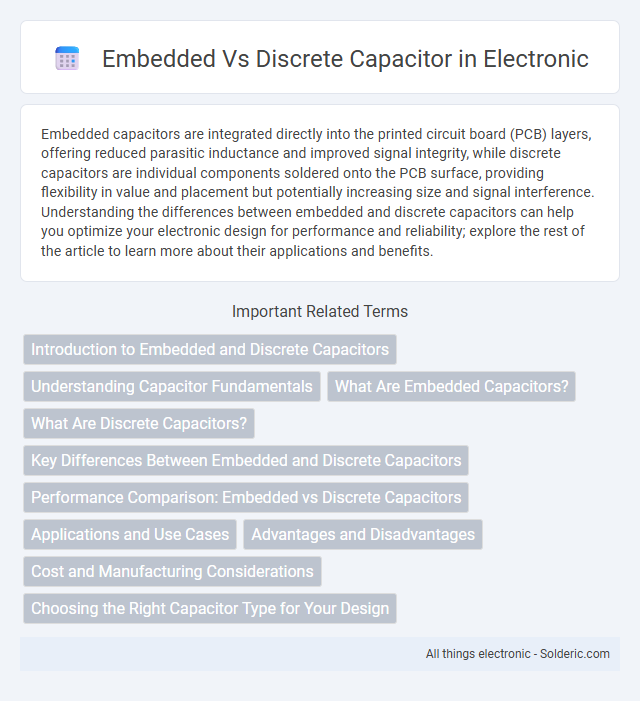Embedded capacitors are integrated directly into the printed circuit board (PCB) layers, offering reduced parasitic inductance and improved signal integrity, while discrete capacitors are individual components soldered onto the PCB surface, providing flexibility in value and placement but potentially increasing size and signal interference. Understanding the differences between embedded and discrete capacitors can help you optimize your electronic design for performance and reliability; explore the rest of the article to learn more about their applications and benefits.
Comparison Table
| Feature | Embedded Capacitor | Discrete Capacitor |
|---|---|---|
| Definition | Capacitors integrated within PCB layers | Separate, standalone capacitor components |
| Size | Smaller, saves board space | Larger, occupies more PCB area |
| Performance | Lower parasitic inductance and resistance | Higher parasitic effects due to leads and packaging |
| Cost | Higher initial PCB fabrication cost | Lower component cost but higher assembly cost |
| Reliability | Improved reliability with reduced solder joints | Potential failure points at solder joints |
| Customization | Fixed capacitance values embedded in design | Flexible capacitance values, easy to replace |
| Application | High-speed, compact, and high-reliability circuits | General purpose, easy prototyping and repairs |
Introduction to Embedded and Discrete Capacitors
Embedded capacitors are integrated directly into the printed circuit board (PCB) substrate, offering reduced parasitic inductance and improved signal integrity for high-frequency applications. Discrete capacitors are separate components soldered onto the PCB surface, providing flexible capacitance options but often introducing greater parasitic effects and occupying more board space. The choice between embedded and discrete capacitors depends on design constraints like size, performance requirements, and manufacturing complexity.
Understanding Capacitor Fundamentals
Embedded capacitors are integrated within printed circuit boards, offering reduced parasitic inductance and improved signal integrity compared to discrete capacitors, which are individual components soldered onto the PCB. Understanding capacitor fundamentals involves recognizing how capacitance, dielectric materials, and placement affect a circuit's performance, especially in high-frequency applications where embedded capacitors provide lower equivalent series resistance (ESR) and enhanced reliability. Your choice between embedded and discrete capacitors depends on design constraints, desired electrical characteristics, and manufacturing considerations.
What Are Embedded Capacitors?
Embedded capacitors are integrated directly into a printed circuit board (PCB) layer, offering reduced parasitic inductance and improved signal integrity compared to discrete capacitors, which are standalone components soldered onto the board surface. These capacitors enhance your device's performance by minimizing space and enabling higher frequency operation, essential in advanced electronics such as 5G and high-speed computing. Utilizing embedded capacitors results in improved power delivery networks and more compact, reliable designs.
What Are Discrete Capacitors?
Discrete capacitors are individual, standalone components designed for specific capacitance levels used in electronic circuits to store and release electrical energy. These capacitors come in various types such as ceramic, electrolytic, and tantalum, each tailored for different applications requiring distinct voltage ratings and temperature stability. Your choice between discrete and embedded capacitors depends on factors like circuit design, space constraints, and electrical performance needs.
Key Differences Between Embedded and Discrete Capacitors
Embedded capacitors are integrated directly into the printed circuit board (PCB) layers, offering reduced parasitic inductance and improved signal integrity compared to discrete capacitors, which are standalone components mounted on the PCB surface. Discrete capacitors provide flexibility in component selection and easier replacement, whereas embedded capacitors contribute to a smaller PCB footprint and enhanced electrical performance, especially in high-frequency applications. Understanding these differences helps you optimize your electronic design for size, performance, and manufacturing efficiency.
Performance Comparison: Embedded vs Discrete Capacitors
Embedded capacitors offer superior high-frequency performance and lower parasitic inductance compared to discrete capacitors, enhancing signal integrity in advanced PCBs. Discrete capacitors provide flexibility in capacitance values and easier replacement but suffer from larger package sizes and higher equivalent series inductance (ESL). Your choice impacts overall device performance, especially in high-speed or miniaturized electronics where embedded capacitors reduce noise and improve power distribution.
Applications and Use Cases
Embedded capacitors are ideal for high-frequency applications such as RF circuits and advanced mobile devices, where space-saving and reduced parasitics enhance performance. Discrete capacitors suit versatile designs including power supply filtering, decoupling, and general electronics repair, offering easy replacement and customization. Your choice depends on whether miniaturization and integration or flexibility and straightforward maintenance are prioritized.
Advantages and Disadvantages
Embedded capacitors offer improved signal integrity and reduced parasitic inductance, enhancing high-frequency performance and saving PCB space, but they are less flexible for circuit modifications and can be more expensive to implement. Discrete capacitors provide easy replacement and customization options with lower initial costs but can introduce unwanted inductance, take up more board area, and potentially degrade high-speed signal quality. Understanding your design priorities helps optimize capacitor choice for performance and cost-efficiency.
Cost and Manufacturing Considerations
Embedded capacitors reduce overall system cost by minimizing PCB space and lowering assembly steps, though initial tooling and design complexity can increase upfront expenses. Discrete capacitors offer simpler manufacturing with established supply chains and lower component costs but require more board area and additional soldering processes. Cost-effectiveness depends on production volume, with embedded solutions benefiting high-volume runs, while discrete capacitors favor smaller batches or prototype phases.
Choosing the Right Capacitor Type for Your Design
Choosing the right capacitor type for your design depends on factors like size constraints, electrical performance, and reliability requirements. Embedded capacitors offer benefits such as reduced parasitic inductance and improved high-frequency performance, making them ideal for compact, high-speed applications. Discrete capacitors provide greater flexibility in capacitance values and power ratings, suitable for applications demanding easy replacement and component-level customization.
Embedded vs Discrete capacitor Infographic

 solderic.com
solderic.com